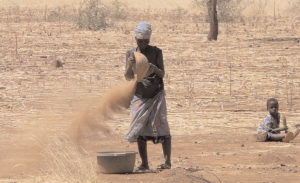At a recent Richmond Club luncheon at the tony National Club, in Toronto, Don Willoughby of Goldrush Resources (GOD-V, GDRRF-O) generated some laughs when he kicked off his presentation with references to the company’s stock symbol, which spells god.
But the vice-president of corporate development went on to say that the junior exploration company has a lot more going for it than that.
In January, Goldrush released results from its program of 19 infill diamond- drill holes totalling 2,000 metres and 16 trenches totalling 1,530 metres that have been excavated at its Ronguen gold property in Burkina Faso, in West Africa.
Highlights from core drilling include 14.83 grams gold per tonne over 6 metres and 12.37 grams gold over 3 metres.
Assay highlights from trenching include 22.14 grams gold over 14.6 metres, including 160.2 grams gold over 1.4 metres and 7.21 grams gold over 9.1 metres.
Ronguen is “eminently openpittable,” Willoughby said, and Goldrush expects to release a National Instrument (NI) 43-101 resource on the property by the end of March.
Ronguen is situated 6 km northwest of High River Gold Mines’ (HRG-T, HRIVF-O) Bissa project, a cluster of permits about 80 km north of the capital, Ouagadougou.
High River, which has operated for more than 14 years in the country and has one producing gold mine already at Taparko, holds a 12% stake in Goldrush.
Under an agreement with High River, Goldrush can truck its ore to Bissa, where High River is likely to build a mill within the next several years.
That means Goldrush “can begin mining with much smaller deposits,” Willoughby said, and avoid the roughly US$100 million in capital costs that would be required to build a mill on its own.
Dan Hrushewsky, vice-president of investor relations at High River told The Northern Miner that Burkina Faso is an emerging gold mining country with the same rocks that host the world-class gold mines of Ghana and Mali.
“They’re the same rocks, but there hasn’t been any recent commercial mining until we started producing gold at the Taparko- Bouroum gold mine in August last year,” he said.
In the last two years, Goldrush has raised $8.25 million and holds $2.7 million in cash. It has a market capitalization of about $20 million, with a stock price that has hovered between 20 and 40 over the last year, and is currently trading at about 30 per share.
Like many in his industry, Willoughby argued his company’s stock is undervalued, but said he hopes that once the NI 43-101 resource is released, “people will start doing some arithmetic.”
Goldrush holds the largest land position of any explorer in the country with 33 permits stretching over 5,790 sq. km.
“There are numerous artisanal sites where women are panning deposits at the top of the holes,” he said. “They are excellent pathfinders to gold mineralization. . . We’ve got years of work ahead of us on those thirty-three permits.”
In a country where 85% of the population survives on less than US$2 per day, Willoughby also noted that Burkina Faso is desperate to develop industry other than agriculture and “supports mining exploration in spades.”
Hrushewsky of High River added that the government is so keen to kick-start mining in the country that it is bending over backwards to be helpful.
“They opened a customs office right at our mine’s gates to facilitate bringing machinery right into the mine,” he said.
Under the country’s mining code, the government takes a 10% carried interest in all mining projects, receives a 3% net smelter royalty and has set the corporate tax rate at 25%.
Apart from Tanzania, Goldrush is exploring for opportunities in other nations in West Africa, such as Mali and Morocco.
“All of the easy gold has been found, so it is necessary to go to more remote places and drill deeper,” Willoughby said. “Relative to Canada, there has been very little mineral exploration of any type done in Burkina Faso, let alone sophisticated exploration, and consequently little has been found. So it’s like exploring Canada’s Precambrian shield a century or two ago.”


Be the first to comment on "Goldrush follows the artisanal miners in Burkina Faso"